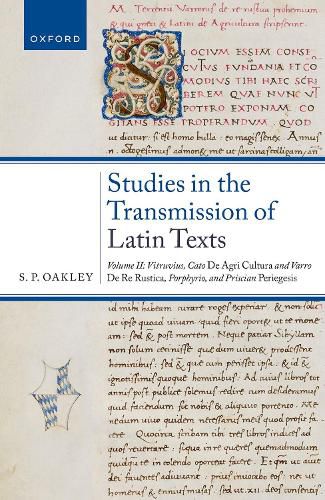Readings Newsletter
Become a Readings Member to make your shopping experience even easier.
Sign in or sign up for free!
You’re not far away from qualifying for FREE standard shipping within Australia
You’ve qualified for FREE standard shipping within Australia
The cart is loading…






This volumes offers a study of all known manuscripts and incunabular editions of four classical texts: Vitruvius' De architectura, Cato's De agri cultura, Varro's De re rustica, Porphyrio's Commentary on Horace, and Priscian's Periegesis. The total number of witnesses involved comes to over 200; many of the manuscripts were produced in France or Italy, but English, German, Polish, and Swiss manuscripts also feature. For each text, the genealogical affiliations of its manuscript copies are determined (in many cases for the first time), as is the manner in which each was dispersed throughout medieval Europe and transmitted from antiquity through the Middle Ages to the first printed editions. S. P. Oakley shows that clear and decisive results can be achieved by application of the so-called stemmatic method and establishes which manuscripts future editors should use in editing these texts. Manuscripts that are not needed by future editors are discussed as fully as those that are, and many localizations and derivations are established. The result is a detailed study that deepens knowledge of the transmission of classical Latin texts, especially in the Renaissance, of scribal practice, and of techniques that can be deployed in the genealogical study of manuscripts and incunables.
$9.00 standard shipping within Australia
FREE standard shipping within Australia for orders over $100.00
Express & International shipping calculated at checkout
This volumes offers a study of all known manuscripts and incunabular editions of four classical texts: Vitruvius' De architectura, Cato's De agri cultura, Varro's De re rustica, Porphyrio's Commentary on Horace, and Priscian's Periegesis. The total number of witnesses involved comes to over 200; many of the manuscripts were produced in France or Italy, but English, German, Polish, and Swiss manuscripts also feature. For each text, the genealogical affiliations of its manuscript copies are determined (in many cases for the first time), as is the manner in which each was dispersed throughout medieval Europe and transmitted from antiquity through the Middle Ages to the first printed editions. S. P. Oakley shows that clear and decisive results can be achieved by application of the so-called stemmatic method and establishes which manuscripts future editors should use in editing these texts. Manuscripts that are not needed by future editors are discussed as fully as those that are, and many localizations and derivations are established. The result is a detailed study that deepens knowledge of the transmission of classical Latin texts, especially in the Renaissance, of scribal practice, and of techniques that can be deployed in the genealogical study of manuscripts and incunables.